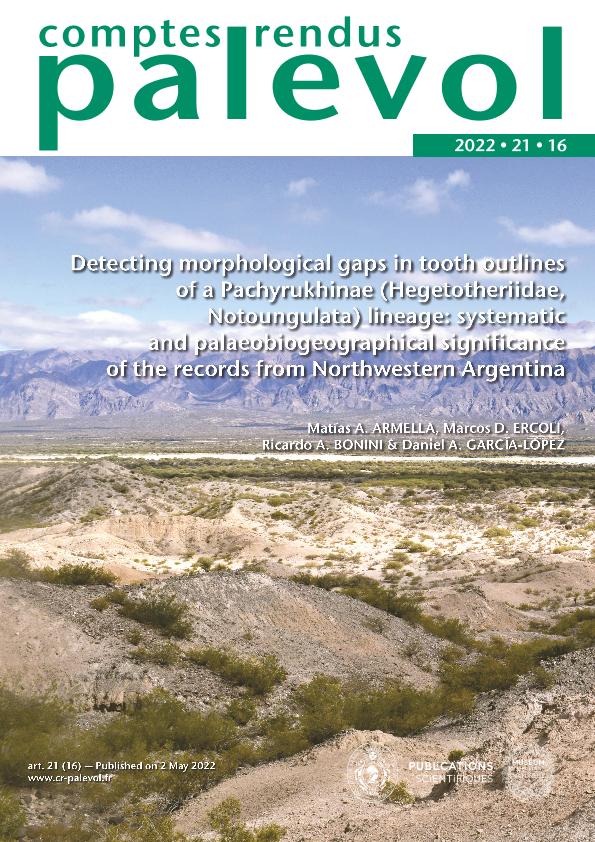Artículo
Pachyrukhinae (Hegetotheriidae, Notoungulata) is a highly frequent clade in the Late Miocene-Pliocene outcrops of southern South America. In Argentina, two genera have been recognized for this span: Tremacyllus Ameghino, 1891 and Paedotherium Burmeister, 1888. The simplified euhypsodontdentition of these Neogene forms creates significant difficulties when cheek teeth are described forsystematic purposes. Tremacyllus has been scarcely studied in comparison with Paedotherium, andtaxonomic analyses have interpreted diagnostic features as intraspecific variations and proposed themonospecific status of the genus. Given the discussion regarding the validity of Tremacyllus speciesand the fact that dental elements are the most abundant remains in the fossil record, we employed aquantitative framework provided by geometric morphometrics and multivariate statistics to discriminatingintra- from interspecific variability by tooth outline. We analyzed a large sample of 82 specimensand two hypotheses were tested: 1) there are morphological gaps within the analyzed sample; and 2)morphology follows a pattern of geographical variation within the sample, suitable for recognition of species. We found that morphological variability is organized into two clusters. Morphological gapsare associated with geographical patterns in the P4 and upper premolars datasets. Based on the classificationof the type specimens and supported cluster structure, we recognize Tremacyllus incipiensRovereto, 1914 as a valid taxon, endemic from western outcrops of Northwestern Argentina. Segregationbetween northern and southern morphologies agrees with two different palaeo-phytogeographicprovinces. This approach proved to be very effective to address intra- and interspecific variation andcontribute to the knowledge of available techniques to assess morphological variation. Les Pachyrukhinae (Hegetotheriidae, Notoungulata) forment un clade très fréquent dans les affleurements du Miocène supérieur-Pliocène du Sud de l’Amérique du Sud. En Argentine, deux genres ont été reconnus pour cette période : Tremacyllus Ameghino, 1891 et Paedotherium Burmeister, 1888. La dentition euhypsodonte simplifiée de ces formes néogènes entraîne des difficultés importantes lorsque les dents de la joue sont décrites à des fins systématiques. Tremacyllus a été peu étudié par rapport à Paedotherium et les analyses taxonomiques ont interprété les caractéristiques diagnostiques comme des variations intraspécifiques, proposant un statut monospécifique du genre. Étant donné la discussion concernant la validité des espèces de Tremacyllus et le fait que les éléments dentaires sont les restes les plus abondants dans les archives fossiles, nous avons employé le cadre quantitatif fourni par la morphométrie géométrique et les statistiques multivariées pour discriminer la variabilité intra- et interspécifique par la morphologie du contour des dents. Nous avons analysé un large échantillon de 82 spécimens et deux hypothèses ont été testées : 1) il existe des lacunes morphologiques au sein de l’échantillon analysé; et 2) la morphologie suit un modèle de variation géographique au sein de l’échantillon, adapté à la reconnaissance des espèces. Nous avons constaté que la variabilité morphologique est organisée en deux groupes. Les lacunes morphologiques sont associées à des modèles géographiques sur les ensembles de données P4 et prémolaires supérieures. Sur la base de la classification des spécimens types et de la structure des clusters soutenue, nous reconnaissons Tremacyllus incipiens Rovereto, 1914 comme un taxon valide, endémique des affleurements occidentaux du nord-ouest de l’Argentine. La ségrégation entre les morphologies du nord et du sud correspond à deux provinces paléo-phytogéographiques différentes. Cette approche s’est avérée très efficace pour aborder la variation intra- et interspécifique et contribuer à la connaissance des techniques disponibles pour évaluer la variation morphologique.
Detecting morphological gaps in tooth outlines of a Pachyrukhinae (Hegetotheriidae, Notoungulata) lineage: systematic and palaeobiogeographical significance of the records from Northwestern Argentina
Título:
Détection des lacunes morphologiques dans les contours des dents d’une lignée de Pachyrukhinae (Hegetotheriidae, Notoungulata): signification systématique et paléobiogéographique des enregistrements du NordOuest de l’Argentine
Armella, Matías Alberto ; Ercoli, Marcos Darío
; Ercoli, Marcos Darío ; Bonini, Ricardo Adolfo
; Bonini, Ricardo Adolfo ; Garcia Lopez, Daniel Alfredo
; Garcia Lopez, Daniel Alfredo
 ; Ercoli, Marcos Darío
; Ercoli, Marcos Darío ; Bonini, Ricardo Adolfo
; Bonini, Ricardo Adolfo ; Garcia Lopez, Daniel Alfredo
; Garcia Lopez, Daniel Alfredo
Fecha de publicación:
05/2022
Editorial:
Elsevier France-Editions Scientifiques Medicales Elsevier
Revista:
Comptes Rendus Palevol
ISSN:
1631-0683
e-ISSN:
1777-571X
Idioma:
Inglés
Tipo de recurso:
Artículo publicado
Clasificación temática:
Resumen
Archivos asociados
Licencia
Identificadores
Colecciones
Articulos(INSUGEO)
Articulos de INST.SUP.DE CORRELACION GEOLOGICA
Articulos de INST.SUP.DE CORRELACION GEOLOGICA
Citación
Armella, Matías Alberto; Ercoli, Marcos Darío; Bonini, Ricardo Adolfo; Garcia Lopez, Daniel Alfredo; Detecting morphological gaps in tooth outlines of a Pachyrukhinae (Hegetotheriidae, Notoungulata) lineage: systematic and palaeobiogeographical significance of the records from Northwestern Argentina; Elsevier France-Editions Scientifiques Medicales Elsevier; Comptes Rendus Palevol; 16; 5-2022; 323-348
Compartir
Altmétricas



